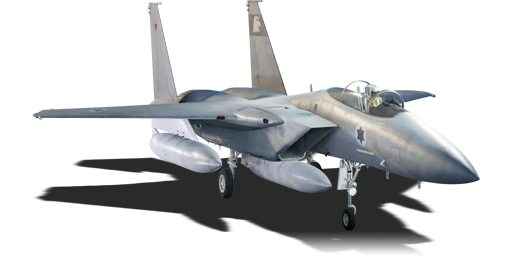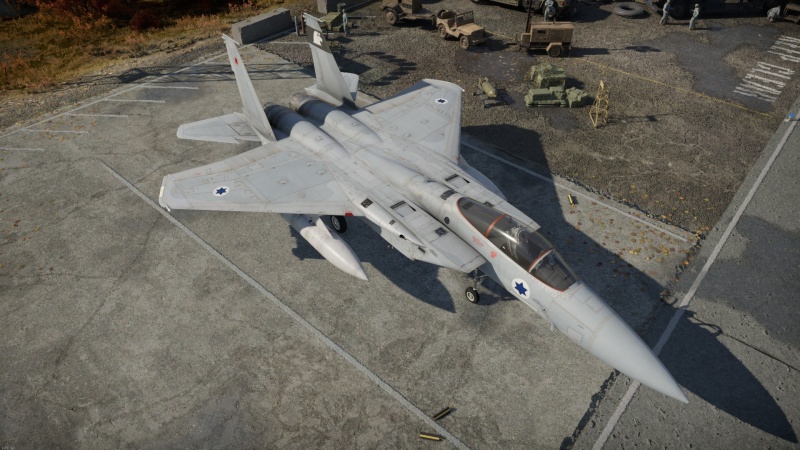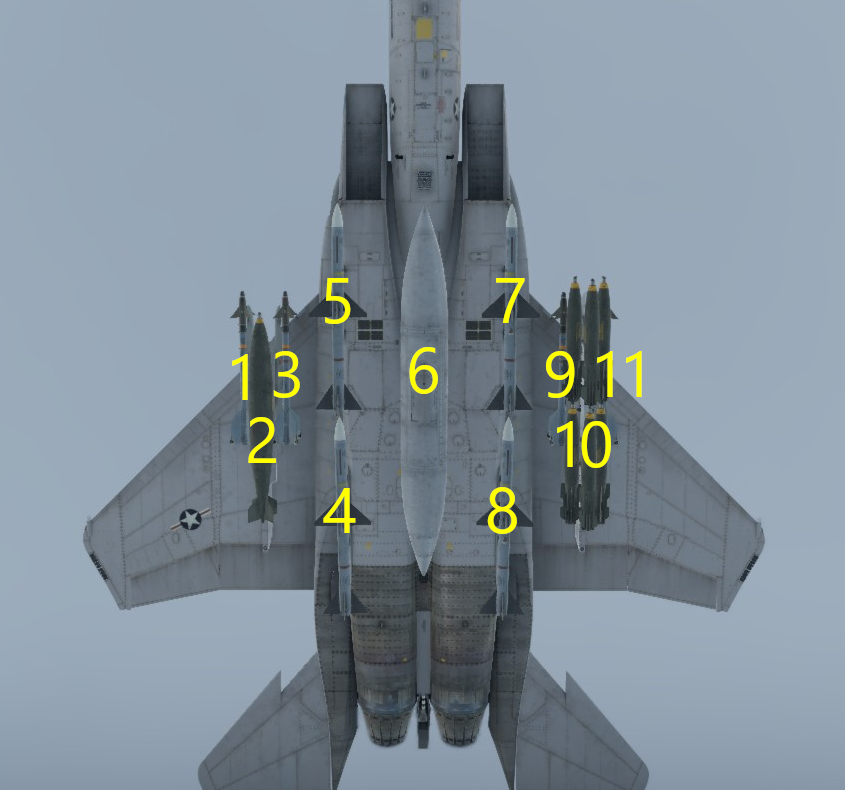Difference between revisions of "Baz"
Colok76286 (talk | contribs) (→Media: Added skins) |
Colok76286 (talk | contribs) (→See also: Edits) |
||
| Line 240: | Line 240: | ||
* ''reference to the series of the aircraft;'' | * ''reference to the series of the aircraft;'' | ||
* ''links to approximate analogues of other nations and research trees.'' --> | * ''links to approximate analogues of other nations and research trees.'' --> | ||
| − | |||
| − | + | ;Related development | |
| − | * | + | * [[F-15 (Family)]] |
== External links == | == External links == | ||
Revision as of 14:40, 28 April 2024
Contents
Description
In the late 1970s, under the Peace Fox I program, Israel recieved its first shipment of the latest F-15A Eagle air superiority fighters, and shortly after, the second shipment was temporarily embargo'd as a result of the 1982 Lebanon War. However, that did not matter to the Israelis, as even a single F-15 was a landslide advantage in the air wars of the Middle East, making short work of 30 year old Syrian MiG-21s that tried to face it. The Israeli F-15A, nicknamed the Baz ("Falcon") would score the premiere kill for the F-15 in aerial combat, against a Syrian MiG-21, in 1978, and would start the totem pole of air dominance that defines the F-15's service record. Of the 103+ confirmed aerial kills the F-15 has scored during its service life, Israeli F-15s are responsible for over 80 of them, and the Baz is the concrete starting ground for this long lasting legacy.
The F-15A Baz, introduced in Update "Air Superiority", is Israel's counterpart to the F-15s found in the American and Japanese tech trees. As a result, the Baz plays almost identically to its Eagle brothers in the other trees, with a few minor differences. The main difference, is that unlike the American and Japanese Eagles, the Baz has access to the Python 3 missile, in addition to the usual selection of AIM-9L and M. The Baz is best played to the same advantages as the other Eagles; do not get too slow, as high-AoA fighters like the JAS39 and the Su-27 will utilize their low speed dogfighting advantages (HMD missiles and high AoA control) against you. Instead, rely on your own advantages, such as the absurd thrust-to-weight ratio from the powerful engines and the very stable airframe, to set up high-speed engagements in scenarios that favor the Eagle's high speed performance.
General info
Flight performance
Describe how the aircraft behaves in the air. Speed, manoeuvrability, acceleration and allowable loads - these are the most important characteristics of the vehicle.
| Characteristics | Max speed (km/h at _,___ m) |
Max altitude (metres) |
Turn time (seconds) |
Rate of climb (metres/second) |
Take-off run (metres) | |||
|---|---|---|---|---|---|---|---|---|
| AB | RB | AB | RB | AB | RB | |||
| Stock | ___ | ___ | 16764 | __._ | __._ | __._ | __._ | ___ |
| Upgraded | ___ | ___ | __._ | __._ | __._ | __._ | ||
Details
| Features | |||||
|---|---|---|---|---|---|
| Combat flaps | Take-off flaps | Landing flaps | Air brakes | Arrestor gear | Drogue chute |
| _ | _ | _ | _ | _ | _ |
| Limits | ||||||
|---|---|---|---|---|---|---|
| Wings (km/h) | Gear (km/h) | Flaps (km/h) | Max Static G | |||
| Combat | Take-off | Landing | + | - | ||
| 1,629 | 700 | - | 548 | 481 | ~__ | ~__ |
| Optimal velocities (km/h) | |||
|---|---|---|---|
| Ailerons | Rudder | Elevators | Radiator |
| < 680 | < 750 | < 700 | - |
Engine performance
| Engine | Aircraft mass | ||||||
|---|---|---|---|---|---|---|---|
| Engine name | Number | Basic mass | Wing loading (full fuel) | ||||
| Pratt & Whitney F100-PW-100 | 2 | 12,500 kg | 314 kg/m2 | ||||
| Engine characteristics | Mass with fuel (no weapons load) | Max Gross Weight | |||||
| Weight (each) | Type | 10m fuel | 20m fuel | 30m fuel | 34m fuel | ||
| 1,470 kg | Afterburning low-bypass turbofan | 14,065 kg | 15,528 kg | 17,042 kg | 17,715 kg | 27,718 kg | |
| Maximum engine thrust @ 0 m (RB/SB) | Thrust to weight ratio @ 0 m (WEP) | ||||||
| Condition | 100% | WEP | 10m fuel | 20m fuel | 30m fuel | 34m fuel | MGW |
| Stationary | 6,140 kgf | 8,510 kgf | 1.21 | 1.10 | 1.00 | 0.96 | 0.61 |
| Optimal | 7,061 kgf (1,629 km/h) |
13,939 kgf (1,200 km/h) |
1.98 | 1.80 | 1.64 | 1.57 | 1.01 |
Survivability and armour
Examine the survivability of the aircraft. Note how vulnerable the structure is and how secure the pilot is, whether the fuel tanks are armoured, etc. Describe the armour, if there is any, and also mention the vulnerability of other critical aircraft systems.
Modifications and economy
Armaments
| Ballistic Computer | ||||
|---|---|---|---|---|
| CCIP (Guns) | CCIP (Rockets) | CCIP (Bombs) | CCRP (Bombs) | Lead indicator |
| |
|
|
|
|
Offensive armament
The Baz is armed with:
- 1 x 20 mm M61A1 cannon, wing root-mounted (940 rpg)
- 240 x countermeasures
Suspended armament
The Baz can be outfitted with the following ordnance:
| 1 | 2 | 3 | 4 | 5 | 6 | 7 | 8 | 9 | 10 | 11 | ||
|---|---|---|---|---|---|---|---|---|---|---|---|---|
| 500 lb LDGP Mk 82 bombs | 1, 6 | 1, 6 | 1, 6 | |||||||||
| 500 lb Mk 82 Snakeye bombs | 1, 6 | 1, 6 | 1, 6 | |||||||||
| 2,000 lb GBU-8 bombs | 1 | 1 | 1 | |||||||||
| 2,000 lb LDGP Mk 84 bombs | 1 | 1 | 1 | |||||||||
| BLU-27/B incendiary bombs | 3 | 3 | 3 | |||||||||
| AIM-7M Sparrow missiles | 1 | 1 | 1 | 1 | ||||||||
| AIM-9L Sidewinder missiles | 1 | 1 | 1 | 1 | ||||||||
| AIM-9M Sidewinder missiles | 1 | 1 | 1 | 1 | ||||||||
| Python 3 missiles | 1 | 1 | 1 | 1 | ||||||||
| 610 gal drop tanks | 1* | 1 | 1* | |||||||||
| Maximum permissible loadout weight: 5,448 kg Maximum permissible weight imbalance: 1,000 kg | ||||||||||||
| * Wing-mounted drop tanks must be equipped together | ||||||||||||
| Default weapon presets | |
|---|---|
| |
Usage in battles
Describe the tactics of playing in the aircraft, the features of using aircraft in a team and advice on tactics. Refrain from creating a "guide" - do not impose a single point of view, but instead, give the reader food for thought. Examine the most dangerous enemies and give recommendations on fighting them. If necessary, note the specifics of the game in different modes (AB, RB, SB).
Pros and cons
Summarise and briefly evaluate the vehicle in terms of its characteristics and combat effectiveness. Mark its pros and cons in the bulleted list. Try not to use more than 6 points for each of the characteristics. Avoid using categorical definitions such as "bad", "good" and the like - use substitutions with softer forms such as "inadequate" and "effective".
Pros:
Cons:
History
One of the contributing factors to Israel's swift and overwhelming victory in the Six-Day War of 1967 was its ability to achieve total air superiority at the very outset, partly due to its pre-emptive strike on its neighbours' air bases, but also thanks to the intensive training of its pilots and the superiority of French and American jet fighter technology at the time. However, the subsequent War of Attrition demonstrated that Israel's enemies — and the Soviet Union which supplied them — were determined to counter those advantages by any means necessary. During the War of Attrition, Egyptian and Syrian SAM capabilities became a serious headache for the Israeli Air Force (IAF), and the overwhelming mass of MiG and Sukhoi aircraft deployed by Egypt, Syria and the Soviet Union further countered Israel's advantages. To make matters worse, the new MiG-25 high-altitude, high-speed jet was now being used by Israel's enemies to perform recon missions over its territory, which the IAF repeatedly failed to intercept. These problems came to a head during the Yom Kippur War of 1973, when the IAF lost over a dozen aircraft to SAM interceptions alone, and failed repeatedly to secure air superiority over either of its belligerent neighbours.
Despite having only recently purchased a whole slew of F-4 Phantom IIs in the late 60s, and having recently begun producing its own Mirage variants (in the form of the Nesher), Israel was now forced to modernize its air force yet again to meet these new challenges. The obvious candidates for this modernization effort were the Grumman F-14 and McDonnell Douglas F-15, two of America's newest high-speed, twin-engine air superiority fighters. A committee established to review the two aircraft quickly determined that the F-15 would be the most suitable for Israel's particular needs. Israel was eager to receive the planes as soon as possible, but by 1976 they had barely just entered production to supply the U.S. Airforce. As a result, the Israelis agreed to take four of the existing pre-production planes as part of the first arms deal. Thus, in late 1976, Israel became the first country outside the United States to acquire the F-15. Notably, a delay in the arrival of these planes in Israel on a Friday, December 10, 1976 forced several of the Israeli ministers who had attended the ceremony to break the Sabbath (a mandatory religious day of rest). This resulted in outrage followed by the collapse of the Israeli government, causing a shift of power that has changed Israeli politics ever since.
The reporting name Baz ("Falcon") was assigned to all F-15 A/B/C/Ds purchased by Israel from 1976 all the way through to the 1990s, regardless of their specific models or configurations, making it more difficult to distinguish between various models. Nevertheless, the IAF has periodically modified older Baz F-15s to match the specifications of newer ones, making the distinction less relevant. The exact number of F-15s purchased from each model are also unclear. What is known is that Israel has purchased almost as many two-seater models (B and D) as single-seaters (A and C), with the two-seaters being used mostly for training purposes and recon missions.
Aside from the pre-production planes described earlier, most of the initial F-15As and Bs purchased by Israel were from Production Blocks 5 and 6. As with all fighters purchased by Israel since the 1960s, the Baz was outfitted with several Israeli-made electronic systems, and modified to accept Israeli-made aerial munitions such as the Python and Popeye. Overall, out of all modified Israeli aircraft, the Baz appears to be closest to the original American model. This changed in the late 1990s, when all Baz F-15s in the IAF were upgraded further to the BazMash standard (short for Baz Meshupar, lit. "improved Baz"), and became undeniably different from their American counterparts.
The F-15A was adopted very enthusiastically by Israeli pilots, and quickly became the dominant fighter in the IAF, providing an aerial umbrella that could not be matched by any of its neighbors. This coincided with the peace process between Israel and Egypt, which led to a 1979 treaty between the two countries that radically altered the balance of power in the Middle East. Nevertheless, the Syrian Air Force was not fully deterred, and continued engaging Israel in sporadic battles throughout the end of the 1970s and early 1980s, as the two nations struggled over Syria's increased control of Lebanon. As part of these skirmishes, in 1978 the F-15 scored its world-premier air kill when Israeli pilot Moshe Melnik downed a Syrian MiG-21. Another first for the F-15 and the military aviation world was also scored by a Baz, when one shot down a Syrian MiG-25 for the first time in history.
Baz F-15s continued seeing intense action in Israeli service over the next several years. With the introduction of the F-16 Netz as Israel's new fighter-bomber in 1980, these two American fighters allowed Israel to perform 'Operation Opera' in 1981: an attack on the Osiraq nuclear reactor near Baghdad, Iraq. Ten Baz F-15s provided cover for the operation, though no Iraqi aircraft were ultimately scrambled against them. The Baz F-15's most intense aerial engagement came one year afterwards, when Baz fighters served as the high-altitude interceptors in Operation Mole Cricket 19, a massive SEAD operation designed to destroy the entire Syrian air defense network along its border with Lebanon. With F-16s and F-4s provoking Syrian aircraft to scramble and engage, the F-15s would swoop down and eliminate them en-masse. During the battle, Israeli F-15s shot down a total of 38 enemy MiG-21s, MiG-23s and MiG-23Ms — nearly half the aircraft shot down during the three-day battle — while taking no losses of their own. Throughout the course of the First Lebanon War, Baz F-15s shot down a total of around 80 Syrian aircraft.
From 1976 onward, Israel continued purchasing F-15s of various models for almost twenty years. The last shipment (consisting of older F-15As) was greenlit by Washington thanks to Israel's begrudging agreement not to relatiate against Iraq during the 1991 Gulf War. These F-15As came from U.S. Airforce reserve stocks, and were used by the IAF mostly as spare parts for other planes. In 1995, Israel began upgrading its Baz F-15s to new specifications, with particular attention to all-weather capabilities, improved radar systems, GPS, and network connectivity. At the same time, Israel stopped purchasing any additional Baz F-15s, and switched entirely to the purchase of new F-15E Strike Eagles from a variant made specifically for their purposes: the F-15I Ra'am. Nevertheless, due to the prohibitive costs of F-15 purchases, and the central role this plane fills in Israel's aerial supremacy, The Baz continues to serve in the IAF to this day. It is unknown exactly how old the oldest Baz in service is currently, but it would have to be around 35-40 years old as of 2023, with significant improvements added over the years.
Media
- Skins
See also
- Related development
External links
Paste links to sources and external resources, such as:
- topic on the official game forum;
- other literature.
| McDonnell Aircraft Corporation | |
|---|---|
| Jet Fighters | F2H-2 · F3H-2 |
| F-4C Phantom II · F-4E Phantom II · F-4J Phantom II · F-4S Phantom II | |
| F-15A · F-15C MSIP II · F-15E | |
| Strike Aircraft | AV-8B Plus · AV-8B (NA) |
| Helicopters | AH-6M |
| Export/Licensed | |
| Aircraft | ◄F-4F Early · ◄F-4F · ◄F-4F KWS LV · Phantom FG.1 · Phantom FGR.2 · F-4J(UK) Phantom II · F-4EJ Phantom II · F-4EJ ADTW · Kurnass · Kurnass 2000 |
| F-15J · F-15J(M) · Baz · Baz Meshupar · F-15I Ra’am | |
| ▄AV-8B Plus | |
| Helicopters | Lahatut |
| The McDonnell Aircraft Corporation merged with Douglas Aircraft Company in 1967 to form McDonnell Douglas Corporation. Later it was merged with The Boeing Company in 1997. | |
| See Also | Mitsubishi Heavy Industries |
| Israel jet aircraft | |
|---|---|
| Kfir Canard · Kfir C.2 · Kfir C.7 · Nesher | |
| Britain | |
| Meteor | Meteor NF.13 · Meteor F.8 |
| France | |
| Vautour | Vautour IIA · Vautour IIN |
| Super Mystere | Sambad · Sa'ar |
| Mirage III | Shahak |
| Other | M.D.450B Ouragan · Mystere IVA |
| USA | |
| F-84 | F-84F |
| A-4 | A-4H · A-4E Early (M) · A-4E · Ayit |
| F-4 | Kurnass · Kurnass 2000 |
| F-15 | Baz · Baz Meshupar · F-15I Ra’am |
| F-16 | Netz · F-16C Barak II · F-16D Barak II |






